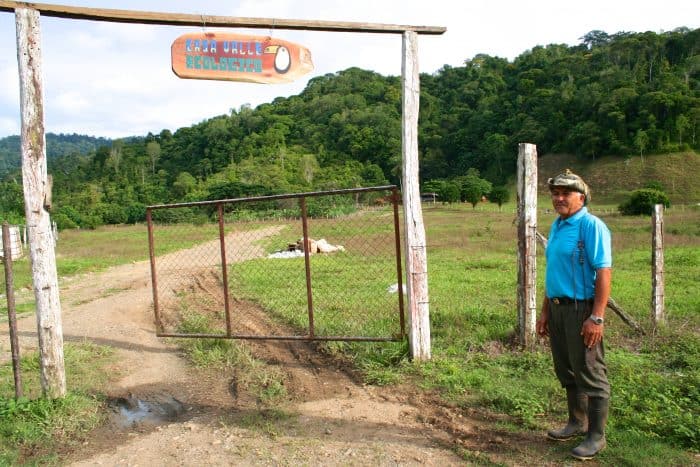Caminatas, or hikes, have become a popular way to promote an issue or call attention to a problem. It seems like every week there is a caminata for some cause, such as nonviolence, health, the environment or animal rights. White T-shirts, sometimes with slogans, are the fashion for a caminata, with a baseball cap or visor to keep hair in place and sun out of eyes completing the uniform.
Some caminatas draw hundreds of marchers and lots of TV coverage, like the one calling attention to breast cancer.
In our little community, a caminata for peace and the environment drew about 20 people, and the president never heard of it. Half the marchers were children, but that was part of the plan, as they are the ones who will have to deal with our messes in the future. The march was organized by a young local mother named Andrea, who was inspired by her interest in children and nature. It was 8:30 on a Saturday morning when we set off.
Our part of rural Alajuela province does not have many natural spectaculars. No waterfalls higher than 2 feet. No jungles replete with exotic animals and colorful birds, unless you consider gray colorful. And the only trail vehicle we saw was don Gilberto’s tractor, which enveloped us in a dust cloud as it passed.
Our walk took us through a cafetal, or coffee plantation, owned by a man nicknamed Delgado (Slim) who is said to be fat.
We expected that a cafetal would be pristine with lots of shiny green leaves to ward off the rain, and popping with white flowers for the November harvest. But no – there was trash everywhere, accumulated through years of workers leaving behind plastic remnants: beverage and food containers and old coffee sacks and ties and assortments of other nonbiodegradables. We tried our best to clean up, but our few carry-along bags were totally inadequate and rapidly began to overflow. Andrea pointed out how even the smallest piece of plastic goes into the seas and pollutes the waters. We will have a cleanup day soon, she promised.
Along our walk, we came upon a huge tree with thigh-sized roots spreading spiderweb-style across the ground. A debate broke out as to whether it was a Guanacaste tree or an higuerón. Gerardo, a local farmer who knows his trees, settled it in favor of the Guanacaste.
We stopped to listen to birds chirping in a tree and stealthily inched close with cameras aimed and ready, resulting in lots of photos of leafy branches. A little farther on, Andrea pointed out a lizard on a tree trunk, and a dozen cameras swung in that direction. Then someone pointed to a pair of vultures high up in a tree, and all the cameras swooped upward. Later, we came upon zompopos, or leaf-cutter ants, and Andrea enlightened us on how they carry their cuttings to huge underground caverns. Nobody took photos of the ants; we see enough of them in our own gardens.
Our trail ran alongside a stream, and Gerardo explained that years ago streams were routed to pass from one farm to another to provide water for irrigation and for oxen to drink. Many have since been filled in. The water trickled and gurgled and formed whirlpools where it encountered obstacles, and cameras moved in to capture pictures. We looked up to see sunlight sifting through branches, and we looked down into ravines. We passed workers’ shacks where children watched us march by, and we gaped at a huge, elegant structure that was home to just two adults; nobody needed to comment on the contrast.
Finally, we reached the end of our journey, the village soccer field, where we all plopped down in a shady spot and someone brought around melon slices and mangoes. In all respects, it was a fruitful morning learning about our own environment and community. It might not have been the biggest caminata in Costa Rica, but just wait until next year.






